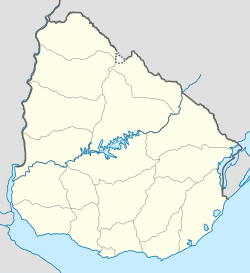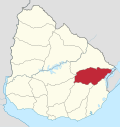Cerro Chato
Cerro Chato | |
|---|---|
Town | |
 Parish Sagrado Corazón & Club Democrático. | |
| Coordinates: 33°6′0″S 55°8′0″W / 33.10000°S 55.13333°W | |
| Country | |
| Departments | Durazno Department Florida Department Treinta y Tres Department |
| Population (2011) | |
| • Total | 3,227 |
| Time zone | UTC -3 |
| Postal code | 30204 |
| Dial plan | +598 4466 (+4 digits) |
| 3 ISO codes: UY-DU, UY-FD, UY-TT | |
Cerro Chato (locally [ˈsero ˈtʃato], Plain Hill) is a town in central Uruguay that is divided in three parts belonging to Durazno Department, Florida Department, and Treinta y Tres Department.
Geography[edit]
The town is located along Route 7, northeast by road from Valentines and southwest of Santa Clara de Olimar.
History[edit]
On 8 January 1942, Cerro Chato was declared a "Pueblo" (village) by the Act of Ley Nº 10.112.[1] Its status was elevated to "Villa" (town) by the Act of Ley Nº 13.299 on 17 November 1964.[2]
Plebiscite of Cerro Chato of 1927[edit]
In 1927, a non-binding plebiscite took place in Cerro Chato to decide to which department it would belong: Durazno, Florida or Treinta y Tres. For this referendum, every citizen of the town was called to vote, including women. That was the first time in Latin America that women exercised the right to vote.[3] The Department of Durazno won the plebiscite, but this result was not accepted by the authorities. Therefore, Cerro Chato still is split between the three departments.
Population[edit]
According to the 2004 census it had a total population of 3,227, of these 1,694 in Trenta y Tres,[4] 1,124 in Durazno[5] and 409 in Florida.[6]
| Year | Population |
|---|---|
| 1963 | 2,513 |
| 1975 | 2,582 |
| 1985 | 2,459 |
| 1996 | 2,945 |
| 2004 | 3,278 |
| 2011 | 3,227 |
Source: Instituto Nacional de Estadística de Uruguay[7][8]
Places of worship[edit]
References[edit]
- ^ "Ley Nº 10.112". República Oriental del Uruguay, Poder Legislativo. 1942. Archived from the original on 4 March 2016. Retrieved 3 September 2012.
- ^ "Ley Nº 13.299". República Oriental del Uruguay, Poder Legislativo. 1964. Archived from the original on 6 October 2014. Retrieved 3 September 2012.
- ^ "El voto femenino cumple ochenta años en Uruguay". LaRed21. 2007. Retrieved 6 July 2011.
- ^ "Censos 2011 Cuadros Trenta y Tres". INE. 2012. Archived from the original on 10 October 2012. Retrieved 25 August 2012.
- ^ "Censos 2011 Cuadros Durazno". INE. 2012. Archived from the original on 10 October 2012. Retrieved 25 August 2012.
- ^ "Censos 2011 Florida (needs flash plugin)". INE. 2012. Retrieved 31 August 2012.
- ^ "1963–1996 Statistics / C". Instituto Nacional de Estadística de Uruguay. 2004. Archived from the original (DOC) on 15 June 2013. Retrieved 27 June 2011.
- ^ "Statistics of urban localities (1963–2004)" (PDF). INE. 2012. Archived from the original (PDF) on 13 November 2009. Retrieved 3 September 2012.
External links[edit]




